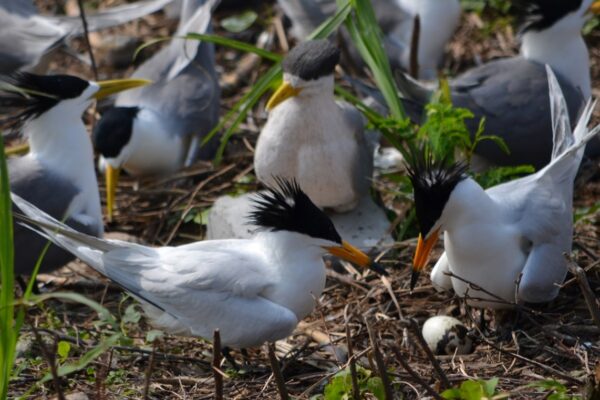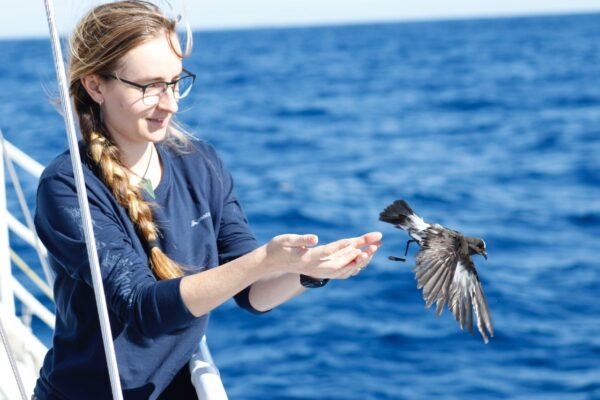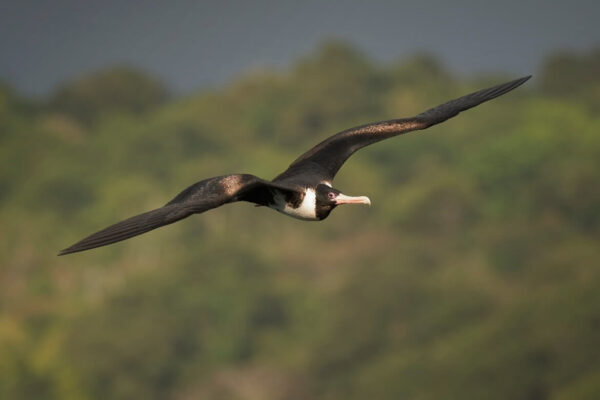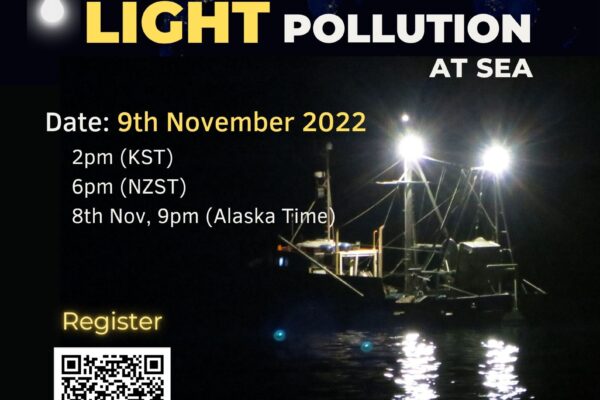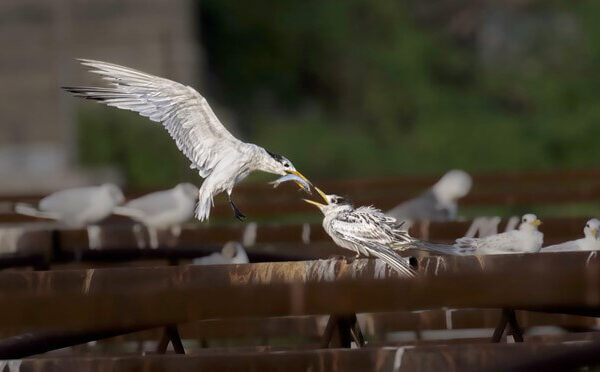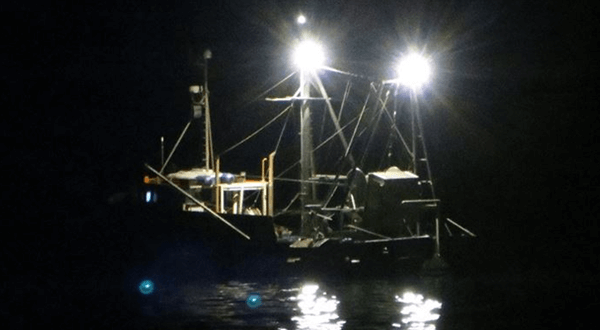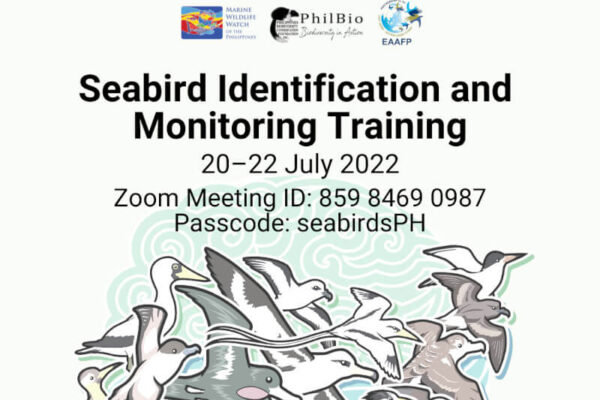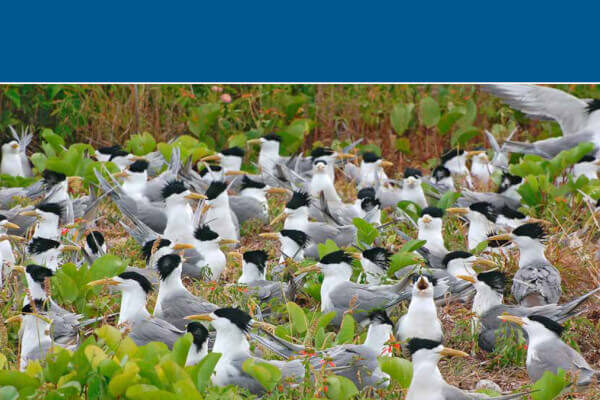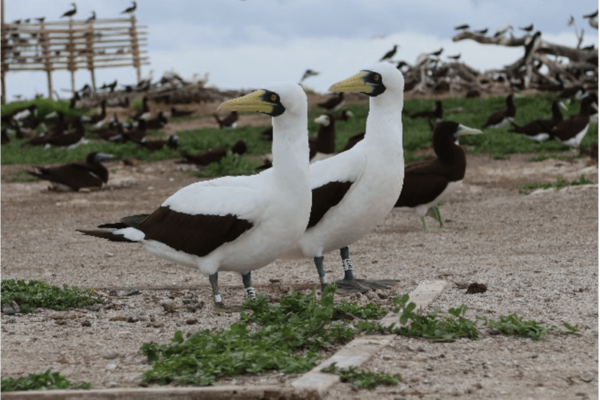-
Special achievement award to the Chinese Crested Tern team
Nesting Chinese Crested Tern on Tiedun Dao of Jiushan Islands next to decoys for social attraction © Simba Chan At the Pacific Seabird Group banquet held at the Birch Aquarium, Scripps Institution of Oceanography, La Jolla, California, 17 February 2023, a Special Achievement Award was presented to three persons who contributed to the recovery of the critically endangered Chinese Crested Tern: Dr Shuihua Chen of the Zhejiang Museum, Prof. Hsiao-wei Yuan of the National University of Taiwan, and Simba Chan of the Japan Bird Research Association/Wild Bird Society of Japan. This is the third time the Pacific Seabird Group presented a Special Achievement Award to Asian seabird researchers. Previous awardees were Prof Hiroshi Hasegawa of Toho University (2001) and Prof Yutaka Watanuki of Hokkaido University (2009). Special Achievement Award presented to Mr. Simba Chan (left), Prof. Hsiao-wei Yuan (middle) and Dr Shuihua Chen (right) at the Pacific Seabird Group meeting © Simba Chan The works of the three awardees were linked to the compilation of the International Single Species Action Plan for the Conservation of the Chinese Crested Tern (Sterna bernsteini) under the Convention of Migratory Species (CMS). After the publication of “Threatened Birds of Asia: The BirdLife International Red Data Book” in 2001, BirdLife International and the CMS have chosen three species for follow-up conservation actions: Spoon-billed Sandpiper, Black-faced Spoonbill and Chinese Crested Tern. These action plans were launched at the 4th Meeting of Partners of EAAFP (MOP4) held in Incheon, Ro Korea, and the International Black-faced Spoonbill Workshop in Fukuoka, Japan, in early 2010 respectively. Simba Chan was the editor-in-chief of the Chinese Crested Tern Action Plan. When he started to work on the action plan in 2005 he contacted Shuihua Chen, who discovered the second breeding ground of Chinese Crested Tern at Jiushan Islands in Zhejiang Province in China in 2004, and Hsiao-wei Yuan who was a tern expert recommended by Dr Lucia Liu Severinghaus of Academia Sinica in Taiwan, who identified the Chinese Crested Tern from photos taken by wildlife documentarist Chieh-te Liang from Matsu in 2000. The trio met at Zhejiang Museum of Natural History in Hangzhou on May 2006 and that should be the start of the Chinese Crested Tern saga. Meeting on the Chinese Crested Tern Action Plan in Hangzhou on 22 May 2006. © Simba Chan In the 2000s the biggest threat known to Chinese Crested Terns was illegal egg collection. The BirdLife/Hong Kong Bird Watching Society China Programme worked with bird conservation organizations in Zhejiang and Fujian on promotion of local awareness in seabird conservation. For this purpose an international seabird symposium was convened in Xiangshan in July 2010. Prof Daniel Roby of Oregan State University was invited and he made a presentation on social attraction project of Caspian Tern in northwest USA. The talk initiated the interest of breeding site restoration and workshops on the feasibility of using social attraction at Jiushan Islands in Zhejiang Province of China were held in 2011, 2012 and 2013. The first attempt of social attraction in 2013 was a late success (no terns were attracted to the site until the playback system was fixed in mid-July, then terns started to breed despite it was very late in the season) and monitoring on the island in 2014 and 2015 confirmed the method worked. Since then, Jiushan became the main breeding site of the Chinese Crested Tern and 20 or more chicks fledged every year (expect 2016). The global population of Chinese Crested Tern in 2013 was less than 50 birds. In 2023 its number increased to around 200 birds. Chan, Chen, Yuan on Tiedun Dao for restoration of the Chinese Crested Tern colony at Jiusha Islan, Zhejiang, China on 17 July 2015. © Simba Chan This is not the end of the story, in late 2022, Simba Chan and Yat-tung Yu, Director of the Hong Kong Bird Watching Society, convened a virtual workshop for Korean and Chinese researchers on planning of restoration of breeding sites of Chinese Crested Terns in Korea and northern China (especially in the vicinity of Qingdao, where the last colony was recorded in 1937). Chan and Yu have also been working with colleagues from Indonesia and the USA on researching and protecting Chinese Crested Tern wintering sites in eastern Indonesia. We hope more people can support us and join the team. The success of the Chinese Crested Tern conservation was a result of team work, the three awardees are representing those who work hard in the field in mainland China, Taiwan and other countries. The secret of the success was a combination of good planning (the action plan and beyond), a good and dedicated team, and the spirit of international cooperation. Recently the EAAFP Black-faced Spoonbill Working Group worked with the IUCN Stork, Spoonbill, and Ibis Specialist Group on a paper (link) on the success of conservation of the once (prior to 2000) critically endangered Black-faced Spoonbill. The essence of success was the same as we listed above. And we believe this is also a lesson to learn for many other migratory species and species groups in the East Asian-Australasian Flyway. Read also: How Plastic Birds Are Bringing Crested Terns Back From the Brink (published on 2015, available at link)
Continue reading -
“Year of the Terns” Flyway Story Series #18 – Interview with Ms. Edin Whitehead
As EAAFP is designating 2022 the “Year of the Terns,” we are bringing great work and stories on tern conservation to you. The next story is from Ms. Edin Whitehead, who is a seabird scientist and conservation photographer in Aotearoa New Zealand. She was also a judge of the Year of the Terns Photo Contest (link). Photo of her releasing a New Zealand storm petrel @Jochen Zaeschmar EAAFP: Hello Edin, first of all, thank you once again for your effort as a judge to the Year of the Terns Photo Contest. Before we go deep, could you please tell us a little bit about yourself and your background? What brought you to studying seabirds and become a conservation photographer? Two things have always been constant in my life - a love of the outside world, particularly birds, and a love of creating. I started out sketching and painting, and eventually started joining my Dad on birdwatching trips that have morphed into bird photography trips over the years. It’s something we both love to do. I actually started studying Fine Art at university before switching to biology – so I could go on field trips around Aotearoa! I fell in love with seabirds – particularly petrels and albatrosses – after going to sea for the first time. The science and photography parts of my life have just started to combine into a career, and I value being able to use my photographs to share seabird science stories, and advocate for their conservation. EAAFP: We heard that you have recently released a book, Brilliance of Birds. Could you please introduce it to our audience and are there any highlights you would like to share? The Brilliance of Birds was published in 2019 by Penguin Random House New Zealand. It was a collaborative project between me and Skye Wishart, and we like to call it a bit of a celebration of some of the unique bird species that call Aotearoa home. There’s a mix of native and endemic species, as well as some of the introduced ones that people see every day, and we tell stories about their behaviours and biology, as well as their histories and cultural importance. I had so much fun working on the photographs for that book – I spent a year travelling around the country on ‘birdventures’ to meet species I’d never seen before. One of my most special memories from that time was photographing tarapirohe – Black-fronted terns – in the early spring snow in the Eglinton Valley in Fiordland. EAAFP: We found that you have also prepared a report on “Threats to Seabirds of Northern Aotearoa New Zealand” could you share with us the background on why this report was prepared and the processes behind it? Additionally, do you have any key messages from the report you would like to share? Seabirds are the most threatened group of birds in the world, and for well-targeted local conservation management, it’s important to understand which threats are most impacting the birds in your region. The report was put together to collate all the information we had for seabirds in the Northern Aotearoa region, and highlight the knowledge gaps about seabird biology and threats to seabirds that needed to be filled. It has since spurred a number of research projects, which is great. I think one of the key messages from the report was that we need to consider the whole ecosystem when doing conservation management – there’s no point in trying to restore seabird populations on land by controlling predator species if there’s no food in the marine habitat to sustain them. EAAFP: What was the most memorable moment during your expeditions? That’s a difficult question! One of my favourite research expeditions in the past few years was volunteering on a project catching New Zealand storm petrel at sea for a genomics study – to understand if there might be hidden populations on different islands. At the moment, Te Hauturu-o-Toi (Little Barrier Island) is the only place they’re known to breed. Capturing these tiny birds at sea is really tricky! It was hard work, and we would work into the evening if the conditions were calm enough. One evening the sea was like a mirror, and being out in the dinghy to catch the birds was like floating inside a huge prism of pinks and purples, with these tiny black-and-white birds dipping along the surface. There were a few Antipodean albatrosses cruising past as well. I took lots of photographs, but none of them really do justice to how beautiful it was. We caught one last bird just after the sun had set. Storm petrel at sea @Edin Whitehead EAAFP: On your webpage it says you “combine science and storytelling to help people explore our natural world” could you share with us an example of one of these stories? One of my long-term projects is to illustrate and share the lives of the seabirds that live around northern Aotearoa – particularly in Tīkapa Moana, the Hauraki Gulf. There are 27 species of seabirds that breed here, and many of them are species that people will never see unless they go out on the water, sometimes quite far offshore. I want to share the wonder I have in this remarkable diversity, and get people excited about these birds – most people don’t even know that there is a species here that has come back from being thought extinct for over 100 years – the New Zealand storm petrel. I’ve been really lucky to be involved in some of the research on this beautiful little bird, so I get to share some of the behind-the-scenes of seabird science. It’s a topic I often speak on, and I even work it into my photography talks! EAAFP: As a conservation photographer, are there any tips or words of caution you would like to share with other photographers? I think in a world where photography seems to have morphed into a ‘content-creation’ craze on social media where people do anything for ‘likes’, it’s really important to look at what value your photography gives back to the ecosystems that you work in. Ethical wildlife photography, honesty in captioning, and advocating for conservation are all crucial to this. EAAFP: Seeing your online gallery, we see many photos of albatrosses, are they your favorite Seabird Species? Could you share about your favorite seabird? I do love albatrosses and petrels! Their lives fascinate me – how they live far out on the ocean and make huge migrations around the world. I find it hard to say I have one favourite species, but I do have a soft spot for tiny little storm petrels – like the New Zealand storm petrel or White-faced storm petrel. They live in the same wild seas that albatrosses do, but they’re so much smaller and I find their resilience truly remarkable. EAAFP: Lastly, we know you wear many hats as a Doctoral Candidate at the University of Auckland, a conservation photographer, a blogger, an explorer in expeditions and more. How do you balance everything? There is a lot of overlap! I spend time on my own research trips making photographs that I use to communicate conservation issues. Sometimes I do have to prioritise what is most important – my blog has fallen a bit quiet as I work on writing up my thesis at the moment. Grey-faced petrel in purple bag @ Chris Gaskin
Continue reading -
Webinar on Chinese Crested Tern in the Yellow Sea and Seabird Conservation in China
Listed as Critically Endangered on the IUCN’s Red List, the Chinese Crested Tern’s global…
Continue reading -
Conserving Critically Endangered Christmas Island Frigatebird
The Christmas Island Frigatebird (Fregata andrewsi) is a globally threatened migratory seabird; listed as Vulnerable by the International Union for the Conservation of Nature (IUCN). In Australia, the species…
Continue reading -
“Tackling Impact on Seabirds by Light Pollution at Sea” Webinar
Following the 2022 World Migratory Bird Day theme highlighting the impact of Light Pollution on…
Continue reading -
Winners of 2022 “Year of the Terns” Photo Contest Announced!
On the second peak of 2022 World Migratory Bird Day (8th October, 2022), the East Asian-Australasian Flyway Partnership (EAAFP) Secretariat and its Seabird Working Group announced the results of…
Continue reading -
New Zealand Government launched a online tool of using birds to track light pollution at sea
New research has expanded our understanding of which migratory bird species are most threatened by light pollution at sea. A fishing…
Continue reading -
The Philippines conducts its 1st National Training on Seabird Identification and Monitoring
In the effort to increase our knowledge and capacities in conserving seabirds in the Philippines, the Biodiversity Management Bureau of the Department of…
Continue reading -
Australia’s Wildlife Conservation Plan for Seabirds
At the national level in Australia, the Environment Protection and Biodiversity Act 1999 (EPBC Act) provides for the development and…
Continue reading -
Masked Future
The article I wrote, ‘Are the Masked Boobies Home for Good In Tubbataha? A rollercoaster ride on the wings of hope’, was published at the East Asian-Australasian Flyway Partnership website in 2020. It was filled with hope and a smattering of apprehension and despair. Then, I was confident that we would see the resurgence of the masked booby Sula dactylatra population in the Tubbataha Reefs Natural Park Flyway Network Site (EAAF 123) in the Philippines. This singular pair of masked boobies known in the Philippines, has been with us since 2019. The second batch of eggs that it laid resulted in one chick that grew to five months, but which the rangers later found dead for unknown reasons. Marine park rangers regularly monitor the seabirds of Tubbataha, with special attention given to this finicky pair. Rangers built a complicated drainage network to rival that of ancient Rome to ensure the nests remain dry during the rainy season. They would practically walk on tiptoes around these celebrities for fear of causing undue stress. Five times more the pair laid eggs, usually a couple, and these would disappear without a trace, a mystery we have since brought to the attention of seabird experts worldwide through various seabird expert groups. Luckily for us, many were willing to help. Dr. Enriqueta Velarde of the Pacific Seabird group introduced us to Dr. Roxana Torres of the Universidad Nacional Autónoma de México, who specializes in boobies. Like us, Dr. Torres was disconcerted by the breeding failure of our Masked Boobies. At her behest, we tagged the two Masked Booby with metal and plastic ring bands during our seabird census in May 2022 for identification. We are poised to install a camera trap to monitor their breeding behavior and to identify the ‘thief’ of their precious eggs. And so, it is time to wait, to be patient, and to observe in silence. Figure 1. Park ranger, Segundo Conales, and reseracher, Ace Acebuque, installed rings on our lone Masked Booby pair. © B.Jimenez/TMO This couple laid seven pairs of eggs in two years, laying eggs almost every other month during the first quarter of this year alone. It earnestly wants to survive and is working double-time to perpetuate the species. As it is, we can but wait and do what little we can to unmask the future that lies ahead. Meanwhile, the Masked Booby colony we dream of will have to wait. Figure 2. Masked Booby 446 and 256 now sport colored and metal wedding rings. © R.Alarcon/TMO If you have any advice for us, we would be so happy to hear from you! Email Tubbataha at tmo@tubbatahareefs.org or message via Facebook page: @OfficialTubbataha Learn more about this site: https://www.eaaflyway.net/philippines/ Prepared by Angelique Songco, Superintendent, Tubbataha Reefs Natural Park Flyway Network Site
Continue reading

